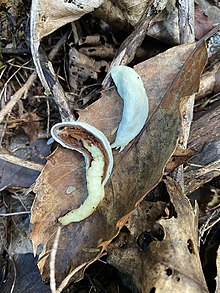Clavogaster virescens
At the time the genus Secotium held numerous species of secotioid and gasteroid fungi, many of which were mistakenly thought to be related due to their similar appearances.
[12] Additional synonyms of Clavogaster virescens are Secotium superbum,[5] described in 1924 as a large and magnificent blue-green secotioid species with a bright yellow stem, and Cauloglossum novozelandicum, described in 1905.
[1] The species epithet virescens means to grow green or verdant like copper rust, and refers to the greenish blue colour of the pouch.
[5][4] The following original texts are reproduced and available to read in full on the website of Manaaki Whenua – Landcare Research, New Zealand's online fungarium.
It has an equal, moderately thin white stem that is fibrous and often hollow, and the gills or gleba are contorted, twisted chambers, sepia or chocolate-brown to purple-brown.
In contrast Clavogaster virescens has reddish-brown to orange gleba enclosed in a sack-like layer, which P. weraroa lacks, arranged in a regular chambered cell-like structure, a solid yellow stem that widens towards the pouch, and no blueing reaction or psychoactive properties.



